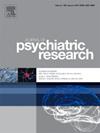Sleep disorders are associated with subsequent depression and anxiety disorders in children and adolescents in Germany-a retrospective cohort study
IF 3.7
2区 医学
Q1 PSYCHIATRY
引用次数: 0
Abstract
Background
This study aims to investigate the longitudinal association between sleep disorders and the subsequent development of depression and anxiety disorders in children and adolescents sleep disorders and subsequent depression in children and adolescents.
Methods
This retrospective cohort study used electronic medical records from the IQVIA™ Disease Analyzer database and included children and adolescents aged 6–17 years with an initial diagnosis of a sleep disorder and without sleep disorders treated by one of 258 office-based pediatricians between January 2010 and December 2023. The five-year cumulative incidence of depression and anxiety disorders in the cohorts with and without sleep disorders was studied with Kaplan-Meier curves. Multivariable Cox regression analyses were used to assess the association between sleep disorders and depression.
Results
The present study included 11,783 children and adolescents with and 58,915 without sleep disorder diagnosis (mean age 10 ± 4 years, 47 % female). Within five years after the index date, 5.3 % of sleep disorder patients and 2.4 % of the matched non-sleep disorder cohort had been diagnosed with depression, and 6.2 % vs. 2.9 % with anxiety disorders. A strong and significant association was observed between sleep disorders and subsequent depression (HR: 2.16; 95 % CI: 1.94–2.39) and anxiety disorder (HR: 2.98; 95 % CI: 1.88–2.30). Upon the exclusion of depression and anxiety disorder diagnoses in the first year after the index date, the association between sleep disorders and both depression (HR: 1.86; 95 % CI: 1.64–2.10) and anxiety disorders (HR: 1.79; 95 % CI: 1.59–2.03) remained strong and significant.
Conclusion
The study indicates a strong and significant association between sleep disorders and depression and anxiety disorders in children and adolescents.
在德国的一项回顾性队列研究中,睡眠障碍与儿童和青少年随后的抑郁和焦虑障碍有关
本研究旨在探讨儿童和青少年睡眠障碍与抑郁和焦虑障碍后续发展的纵向关系。方法:本回顾性队列研究使用IQVIA™疾病分析数据库中的电子医疗记录,纳入了2010年1月至2023年12月258名儿科医生中的一名治疗的6-17岁的儿童和青少年,这些儿童和青少年最初诊断为睡眠障碍,但没有睡眠障碍。用Kaplan-Meier曲线研究了有睡眠障碍和无睡眠障碍人群中抑郁和焦虑障碍的5年累积发病率。多变量Cox回归分析用于评估睡眠障碍与抑郁症之间的关系。结果本研究纳入11783例有睡眠障碍诊断的儿童和青少年,58915例无睡眠障碍诊断的儿童和青少年(平均年龄10±4岁,女性47%)。在索引日期后的五年内,5.3%的睡眠障碍患者和2.4%的匹配的非睡眠障碍队列被诊断为抑郁症,6.2%对2.9%被诊断为焦虑症。在睡眠障碍和随后的抑郁之间观察到强烈而显著的关联(HR: 2.16;95% CI: 1.94-2.39)和焦虑障碍(HR: 2.98;95% ci: 1.88-2.30)。在排除抑郁和焦虑障碍诊断后的第一年,睡眠障碍与两种抑郁症之间的相关性(HR: 1.86;95% CI: 1.64-2.10)和焦虑症(HR: 1.79;95% CI: 1.59-2.03)仍然强劲且显著。结论儿童青少年睡眠障碍与抑郁、焦虑障碍之间存在显著相关性。
本文章由计算机程序翻译,如有差异,请以英文原文为准。
求助全文
约1分钟内获得全文
求助全文
来源期刊

Journal of psychiatric research
医学-精神病学
CiteScore
7.30
自引率
2.10%
发文量
622
审稿时长
130 days
期刊介绍:
Founded in 1961 to report on the latest work in psychiatry and cognate disciplines, the Journal of Psychiatric Research is dedicated to innovative and timely studies of four important areas of research:
(1) clinical studies of all disciplines relating to psychiatric illness, as well as normal human behaviour, including biochemical, physiological, genetic, environmental, social, psychological and epidemiological factors;
(2) basic studies pertaining to psychiatry in such fields as neuropsychopharmacology, neuroendocrinology, electrophysiology, genetics, experimental psychology and epidemiology;
(3) the growing application of clinical laboratory techniques in psychiatry, including imagery and spectroscopy of the brain, molecular biology and computer sciences;
 求助内容:
求助内容: 应助结果提醒方式:
应助结果提醒方式:


